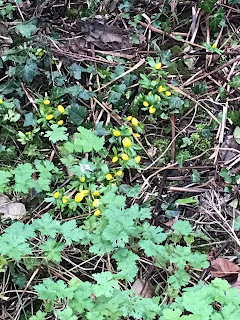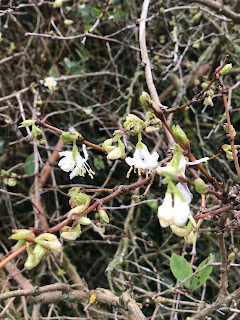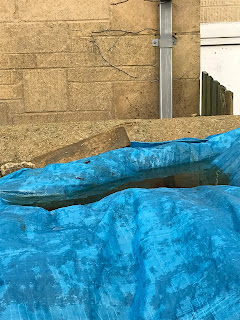 |
| Helleborus x hybridus |
 |
| Winter aconites |
What's happening in a Cotswold garden - plants, weather, birds, other wildlife
 |
| Helleborus x hybridus |
 |
| Winter aconites |
As the days get longer, nature starts moving towards spring, even though the coldest days of the winter are probably still to come. The January weather has been relatively mild for the time of year, on the dry side and with no serious wind. There have been some chilly days and some frosty nights – the max-min thermometer outside the back door registered -4C the other night – but on one sunny day last week there was a definite touch of warmth in the sunshine. Altogether it’s more early spring than midwinter at the moment, and animal and plant life is responding accordingly.
Some of the dahlias are still in the ground outside, with
the remains of the panicum collapsed on top of them; I’m hoping that that might
help protect the dahlia tubers from the worst of the cold. (I am gradually progressing towards being
physically able to bend down and dig them out.)
The panicum is rather dishevelled but modestly pleasing in a Piet Oudolf
sort of way; it’s not my preferred look for the garden, but it’s better than
the straggly strands of old couch grass that prevail in some other parts of the
borders.
 |
| Galanthus elwesii |
The early spring flowers are starting to put on a show; although the first snowdrop to open was one of the Galanthus atkinsii, the first clump to be in full bloom was the G. elwesii under the purple-leaved prunus. The big hellebore in the front garden is showing a few flowers, and the winter honeysuckle (Lonicera x purpusii) is looking – and smelling – good. (It really needs hacking back; it’s a big sprawling shrub which frankly has little to offer for much of the year, but its little scented flowers through the winter and the fresh new foliage in the early spring earn it its keep.) And in the veg plot, the Rhubarb ‘Timperley Early’ is starting to push up its first stalks.
 |
| First hellebore flowers |
 |
| Winter honeysuckle |
 |
| The rhubarb coming to life |
There are also definite signs of spring in the bird world, rather earlier than normal. What I take to be the usual two patio robins – the thin one and the plump ‘Christmas card’ robin – seem to have paired up again and are regularly feeding together, and there have been another two at the opposite side of the house, by the garage. The sparrows that nest above our bedroom window are already refurbishing their home. Usually at this time of year we occasionally see birds, particularly sparrows, picking up a feather or blade of grass, as though they have a vague notion that this will be useful to them in due course but they’re not quite sure how, before dropping it and going on their way regardless; but this year there is definite building work going on, with strands of grass left hanging out of the gutter and the odd dropped feather drifting slowly down past the window. Lefty the lame pigeon is still coming regularly to the patio for breakfast, but his lady is now coming too; perhaps they’re also thinking of nesting?
Down beyond the bottom fence, the pile of big branches from
the big ash tree is still lying in the field; the contractors may be leaving
them until the ground dries out enough for heavy machinery to come and move
them. The wildlife seems to be enjoying
them; one day there was a small flock of finches (chaffinches, goldfinches and
a few greenfinches) poking around in the grass around them, a blackbird (we
have several at the moment) perched on top and a wren fossicking about in the
pile. Fieldfares are making the most of
the windfall apples, a pair of mistle thrushes sometimes perch in the trees and
the long-tailed tit family call by the fatball feeder from time to time. Next weekend is the Big Garden Birdwatch, and
I hope we’ll have a good turnout for that.
 |
| The birds' swimming pool |
Speaking of woodpiles, the firewood stack saved from the felling of the tree on our drive has provided an unexpected amenity for the birds. The wood is covered by an old blue tarpaulin to stop it getting too wet, with various weights on top to keep everything in place (no gales this year yet, but it’s only a matter of time). Because of the irregular shape of the stack, there are dips and hollows in the tarpaulin, and one of these has filled with rainwater, creating an ideal bathtub for pigeons and the odd blackbird. It’s even the right colour for a swimming pool. It wasn’t our intention to create a lido for the birds, but they’re welcome to enjoy it.
 |
| Open or not? |
It was a relatively warm start to 2022; a mild December finished with the warmest New Year’s Eve ever recorded (16C / about 62F in London) and 2022 began with the warmest recorded New Year’s Day (17C / about 63F n London). Not quite so warm here, of course, but still well above the norm. This was followed by a few days of much chillier weather, with a couple of frosts overnight, and now things are swinging back to single figures C during the day.
The mild
weather was evident when I went out to count the number of species with open
flowers on 1st January. Of
course, it depends on what you consider to be an open flower. One of the early snowdrops (the Galanthus atkinsii
down by the summerhouse) was showing the outside of its flower but wasn’t yet
actually opened; but really, you can’t see inside a snowdrop flower anyway unless you
get right down to its level, so does it count or not? Let’s say not, in which case there were 15: the
usual winter shrubs:winter jasmine (jasminum nudiflorum), winter honeysuckle
(lonicera purpusii), the winter viburnums, especially Viburnum x bodnantense
‘Dawn’, Mahonia ‘Winter Sun’ and the rosemary; several out-of-season blooms on
the senecio (or whatever it’s called nowadays); a few blooms on some of the
hardier perennials: Comfrey ‘Hidcote Pink’, the little red chrysanthemums, the alpine
strawberries, some rocket running to seed, and one flower on each of the purple/blue
campanula by the drive (one of the spreaders - portenschlagiana or
poscharskyana?) and the vinca major in the wall; as well as a few weeds:
daisies, euphorbia palustris, and meadow grass.
And a day or so later a creeping buttercup flowered in the lawn.
I discounted a
few plants with summer 2021 flowers still hanging on grimly, but in too poor
condition to be reasonably regarded as ‘flowering’: the rose ‘Blush Noisette’,
the gazanias (now moved into the greenhouse for protection from the frosts) and
a couple of antirrhinums. Likewise a
number of early-flowering plants were showing well-developed buds: the
snowdrops as mentioned above, the hellebores and the choisya. And the first daffodil leaves are nosing up
in the lawn just beyond the buddleja; some supports have been put in place to
stop me walking on them.
The birds have
been visiting in search of food, especially on the colder days. They are mostly the regulars – good numbers
of blue and great tits especially – though a brambling dropped by one morning. A pied wagtail was around one afternoon, scrapping
with one of the robins, and a long-tailed tit (they haven’t been much in evidence
these past few weeks) came to the fatball feeder one day. A tawny owl was calling the other evening
from somewhere very close. We have three
robins in the garden, and two of them are starting to tolerate each other’s
presence as a preliminary stage in their courtship; while we still have to ride
out the worst of the winter, they are obviously already starting to think ahead
to spring!